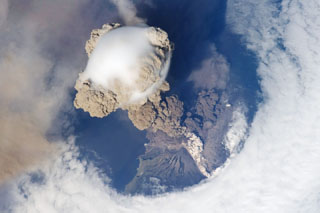Report on Sarychev Peak (Russia) — 10 June-16 June 2009
Smithsonian Institution / US Geological Survey
Weekly Volcanic Activity Report, 10 June-16 June 2009
Managing Editor: Sally Sennert.
Please cite this report as:
Global Volcanism Program, 2009. Report on Sarychev Peak (Russia) (Sennert, S, ed.). Weekly Volcanic Activity Report, 10 June-16 June 2009. Smithsonian Institution and US Geological Survey.
Sarychev Peak
Russia
48.092°N, 153.2°E; summit elev. 1496 m
All times are local (unless otherwise noted)
Based on analysis of satellite imagery, SVERT reported that on 11 June a thermal anomaly from Sarychev Peak and a possible diffuse ash plume were detected. Seismicity was at background levels. The next day, a large thermal anomaly was present and ash emissions were were seen on satellite imagery. On 13 June, ash plumes rose to an altitude of 7.5 km (24,600 ft) a.s.l. and drifted 200 km SW and 105 km SE. On 14 June, a large eruption produced an ash plume that rose to an altitude of 12 km (39,400 ft) a.s.l. A large explosion the next day sent an ash plume to an altitude of 8 km (26,200 ft) a.s.l. Sarychev Peak is not monitored with ground-based instruments. According to news articles, some airlines have re-routed, canceled, or delayed flights.
Geological Summary. Sarychev Peak, one of the most active volcanoes of the Kuril Islands, occupies the NW end of Matua Island in the central Kuriles. The andesitic central cone was constructed within a 3-3.5-km-wide caldera, whose rim is exposed only on the SW side. A dramatic 250-m-wide, very steep-walled crater with a jagged rim caps the volcano. The substantially higher SE rim forms the 1496 m high point of the island. Fresh-looking lava flows, prior to activity in 2009, had descended in all directions, often forming capes along the coast. Much of the lower-angle outer flanks of the volcano are overlain by pyroclastic-flow deposits. Eruptions have been recorded since the 1760s and include both quiet lava effusion and violent explosions. Large eruptions in 1946 and 2009 produced pyroclastic flows that reached the sea.
Sources: The Province, Sakhalin Volcanic Eruption Response Team (SVERT), Canada.com (Postmedia Network)

